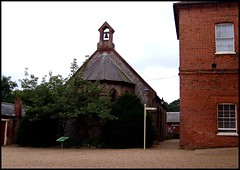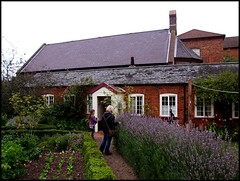
home I index I latest I glossary I introductions I e-mail I about this site
Workhouse chapel, Gressenhall
Read
the captions by hovering over the images, and click on them to
see them enlarged.


| Workhouse
chapel, Gressenhall But, as revolutions in agriculture and industry began to bite, the social structure of England became much more volatile, and the winds of fortune blew more violently, and in uncertain directions. The law, which dated back to Elizabethan times, ruled that the parish was responsible for the relief of the poor who had been born in it. This was not necessarily those who now lived there. Consequently, if a family fell on really hard times, they had to return to the village where one or other of the adults had been born. This system made sense in an age where nobody strayed far from home. But as the 18th century went on, there was greater mobility, and an ebb and flow of population across the country. If a recession bit hard, parishes might find themselves faced with a duty of care that they were ill-equipped to provide. Parish poorhouses were one solution, but another, which made more economic sense, was the creation of a House of Industry by a group of parishes banding together, usually across the Hundred, a Hundred being a larger unit of administration. Here in Gressenhall, in 1777, the Hundreds of Mitford and Launditch came together to incorporate a magnificent House of Industry. It was one of many built in England during the decade. Houses of Industry, or workhouses, were intended to be self-supporting; farming and manufacture would provide an income. Sheep were kept, barley and vegetables were grown. In return, the parish would provide education and food, although at Bulcamp House of Industry in Suffolk it is recorded that the food was provided entirely from the farm run by the inhabitants. Families lived together, and when children reached the age of thirteen they were apprenticed by the incorporation. In general, and given that life was generally poor and uncertain out in the wider world, Houses of Industry in the 18th century do not appear to have been unpleasant places. By the early 19th century, however, England was deep in a recession, and thousands of ex-soldiers discharged after the Napoleonic Wars were becoming a drain on the Parish welfare system. Agriculture was in a slump, and in desperation people sought work in the growing towns. The Population increased, and those seeking relief often had to return to a rural parish with which they no longer had any family connection. The number of inmates arriving at a workhouse from an increasingly wide area, and consequent overcrowding, led to terrible outbreaks of disease. In 1834, for example, more than a sixth of the inmates of Gressenhall House of Industry died of cholera and scarlet fever. It was no longer possible for the poor rate levied by many parishes to pay for the relief of the poor. It became clear to the authorities that more must be done to dissuade the poor from knocking on the workhouse doors. The result was a change of emphasis. In 1835 came the Poor Law Act. In Suffolk, at Bulcamp House of Industry, in the chilling words of White's 1844 Directory, £1000 was expended in altering the workhouse, so as to admit a better classification of the inmates. The word classification, of course, meant segregation; husbands were to be separated from their wives, children from their parents, the deserving from the undeserving poor. The farm at Gressenhall was sold off, and any idea of self-sufficiency was forgotten. The men were put to work on a treadmill that ground corn, or made to pick oakum, which shredded their hands. The workhouse was no longer to be a place to which people would come willingly; from now on, it should be a place of hardship, of coarse fare, of degradation and humility wrote the Reverend Millman; it should be administered with strictness, with severity; it should be as repulsive as is consistent with humanity. It was evil done in the name of good. Through the long Victorian era and into the 20th century, conditions would gradually improve, until by the end of the First World War workhouses were largely superceded by the beginning of the welfare state. Apart from a brief use as a barracks in the First World War, and a Prisoner of War camp in the Second, Gressenhall Workhouse continued providing for the unfortunate, as a hospital for elderly women until the 1960s, and then for a while as a homeless families unit, until it was finally closed in the 1970s. For a long time, it remained empty and derelict, until it was taken in hand by Norfolk County Council. Today, it is the wonderful Gressenhall Museum of Norfolk Rural Life, and includes a major Workhouse exhibit based on the various original rooms. It is haunting to stand in the boys exercise yard and see the graffiti on the wall carved in the later years of the 19th century. Amazingly, some of the names there have been matched to entries in the records. These were real people. As the parish was in charge of the workhouse, you might assume that it would make some provision for the cure of the souls of the inmates. In fact, workhouses were usally ministered by poorly paid chaplaincies, a useful second income for some young curate with a large family. Some Houses of Industry had been equipped with chapels, while others held services in the dining rooms. All workhouse chapels were Anglican; inmates from other denominations could be visited by their ministers, but services on the premises were not permitted. Here at Gressenhall, a chapel was not built until 1868. The designer was Richard Phipson, who was the Diocesan Architect. |
Simon Knott, January 2008
Amazon commission helps cover the running costs of this site.
home I index I latest I introductions I e-mail I about
this site I glossary
Norwich I ruined churches I desktop backgrounds I round tower churches
links I small
print I www.simonknott.co.uk I www.suffolkchurches.co.uk